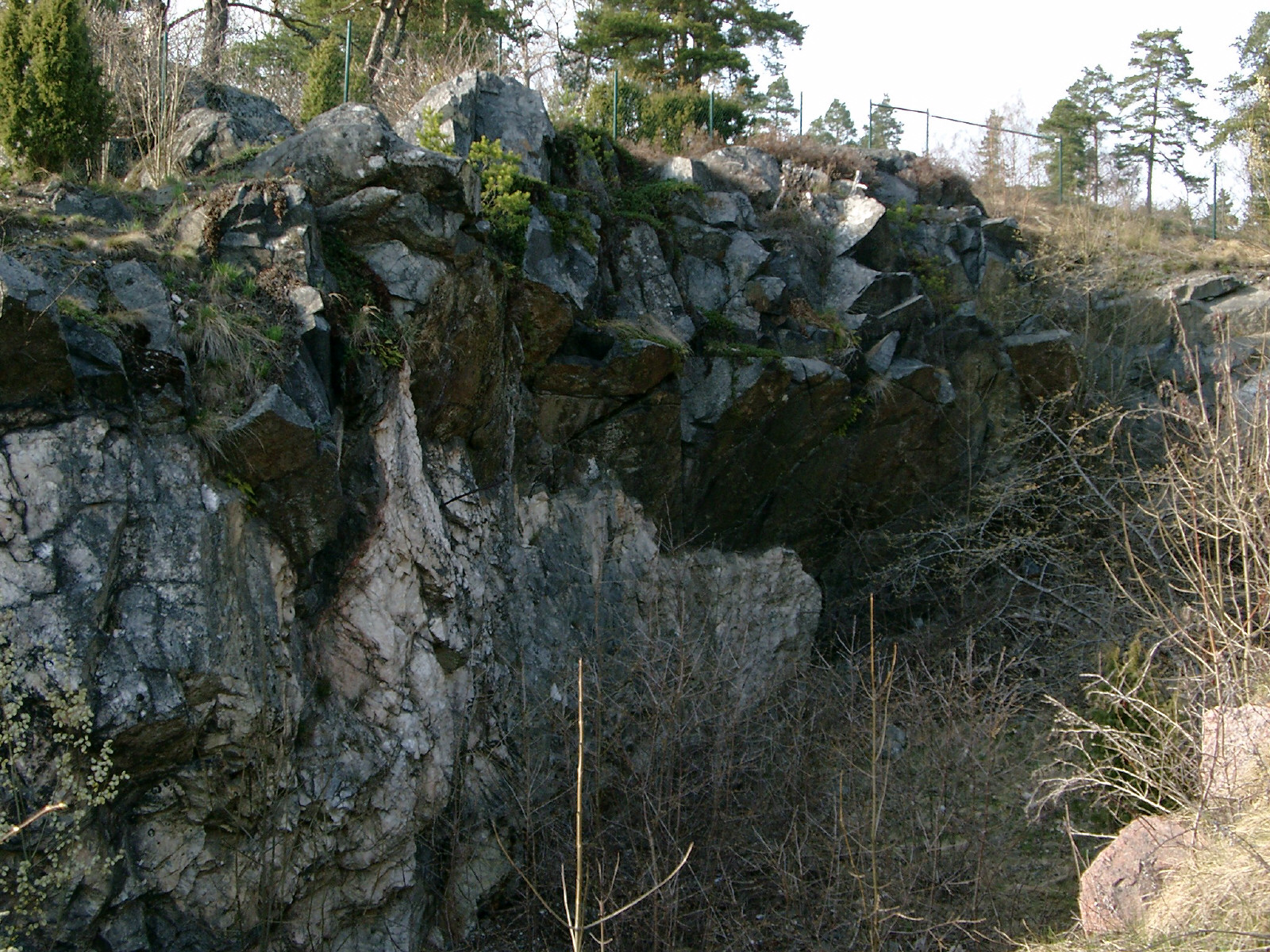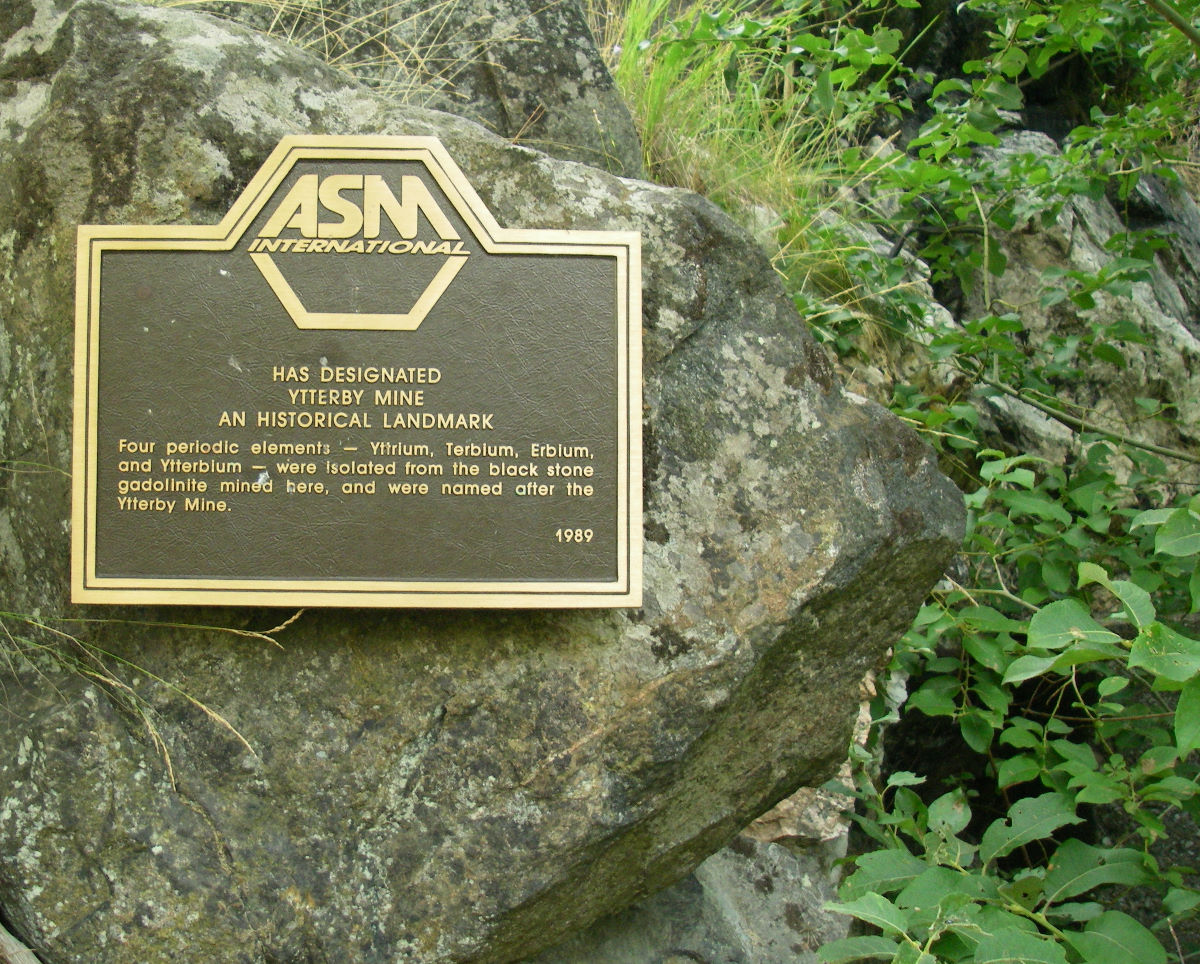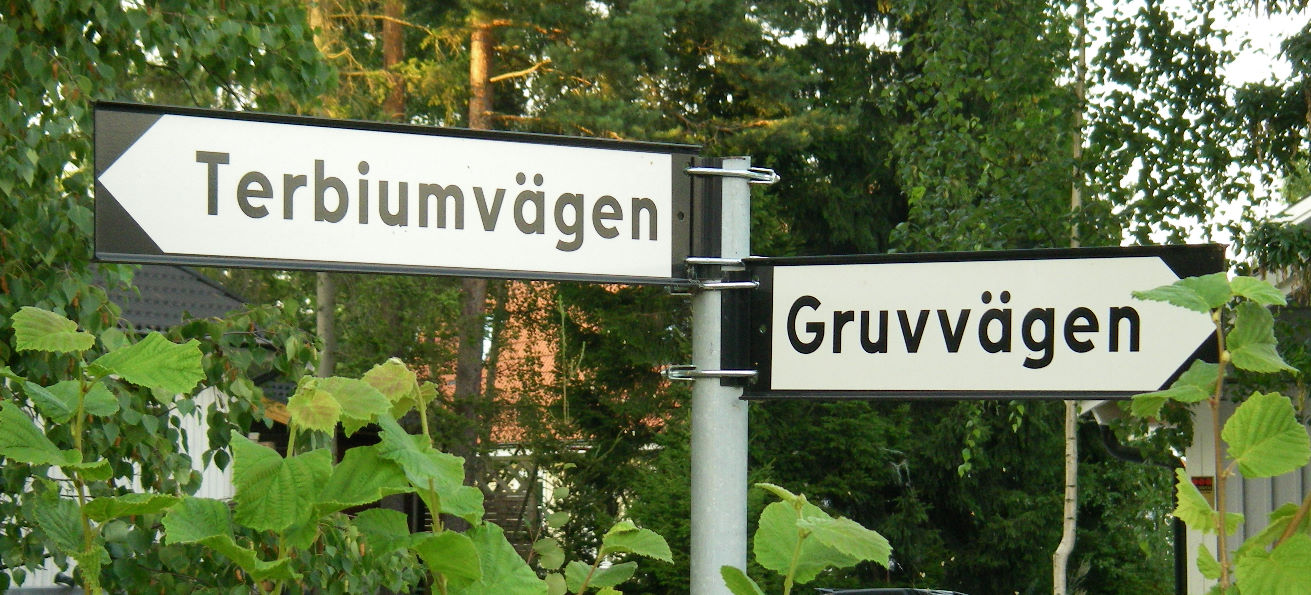|
Ytterby
Ytterby () is a village on the Swedish island of Resarö, in Vaxholm Municipality in the Stockholm archipelago. Today the residential area is dominated by suburban homes. The name of the village translates to "outer village". Ytterby is perhaps most famous for being the single richest source of elemental discoveries in the world; the chemical elements yttrium (Y), terbium (Tb), erbium (Er), and ytterbium (Yb) are all named after Ytterby, while four more elements were first discovered there. Mine Quartz was mined in the area beginning in the 1600s for the ironworks in Uppland. Feldspar was mined for local porcelain manufacture, such as Gustavsberg, and the porcelain trade with Britain and Poland. The mine is likely the first feldspar mine in Sweden, starting in 1790. Feldspar mining was likely sporadic and based on manufacture demand. This demand took off in the 1860s, leading to deeper mining efforts at Ytterby. The mine became one of the most productive quartz and feldspar ... [...More Info...] [...Related Items...] OR: [Wikipedia] [Google] [Baidu] |
Ytterby Gruva 2769
Ytterby () is a village on the Swedish island of Resarö, in Vaxholm Municipality in the Stockholm archipelago. Today the residential area is dominated by suburban homes. The name of the village translates to "outer village". Ytterby is perhaps most famous for being the single richest source of elemental discoveries in the world; the chemical elements yttrium (Y), terbium (Tb), erbium (Er), and ytterbium (Yb) are all named after Ytterby, while four more elements were first discovered there. Mine Quartz was mined in the area beginning in the 1600s for the ironworks in Uppland. Feldspar was mined for local porcelain manufacture, such as Gustavsberg, and the porcelain trade with Britain and Poland. The mine is likely the first feldspar mine in Sweden, starting in 1790. Feldspar mining was likely sporadic and based on manufacture demand. This demand took off in the 1860s, leading to deeper mining efforts at Ytterby. The mine became one of the most productive quartz and feldspar ... [...More Info...] [...Related Items...] OR: [Wikipedia] [Google] [Baidu] |
Ytterby Terbiumvagen Gruvvagen
Ytterby () is a village on the Swedish island of Resarö, in Vaxholm Municipality in the Stockholm archipelago. Today the residential area is dominated by suburban homes. The name of the village translates to "outer village". Ytterby is perhaps most famous for being the single richest source of elemental discoveries in the world; the chemical elements yttrium (Y), terbium (Tb), erbium (Er), and ytterbium (Yb) are all named after Ytterby, while four more elements were first discovered there. Mine Quartz was mined in the area beginning in the 1600s for the ironworks in Uppland. Feldspar was mined for local porcelain manufacture, such as Gustavsberg, and the porcelain trade with Britain and Poland. The mine is likely the first feldspar mine in Sweden, starting in 1790. Feldspar mining was likely sporadic and based on manufacture demand. This demand took off in the 1860s, leading to deeper mining efforts at Ytterby. The mine became one of the most productive quartz and feldspar ... [...More Info...] [...Related Items...] OR: [Wikipedia] [Google] [Baidu] |
Yttrium
Yttrium is a chemical element with the symbol Y and atomic number 39. It is a silvery-metallic transition metal chemically similar to the lanthanides and has often been classified as a "rare-earth element". Yttrium is almost always found in combination with lanthanide elements in rare-earth minerals, and is never found in nature as a free element. 89Y is the only stable isotope, and the only isotope found in the Earth's crust. The most important uses of yttrium are LEDs and phosphors, particularly the red phosphors in television set cathode ray tube displays. Yttrium is also used in the production of electrodes, electrolytes, electronic filters, lasers, superconductors, various medical applications, and tracing various materials to enhance their properties. Yttrium has no known biological role. Exposure to yttrium compounds can cause lung disease in humans. The element is named after '' ytterbite'', a mineral first identified in 1787 by the chemist Carl Axel Arrhenius. He n ... [...More Info...] [...Related Items...] OR: [Wikipedia] [Google] [Baidu] |
Erbium
Erbium is a chemical element with the symbol Er and atomic number 68. A silvery-white solid metal when artificially isolated, natural erbium is always found in chemical combination with other elements. It is a lanthanide, a rare-earth element The rare-earth elements (REE), also called the rare-earth metals or (in context) rare-earth oxides or sometimes the lanthanides (yttrium and scandium are usually included as rare earths), are a set of 17 nearly-indistinguishable lustrous silve ..., originally found in the gadolinite mine in Ytterby, Sweden, which is the source of the element's name. Erbium's principal uses involve its pink-colored Er3+ ions, which have optical fluorescent properties particularly useful in certain laser applications. Erbium-doped glasses or crystals can be used as optical amplification media, where Er3+ ions are optically pumped at around 980 or and then radiate light at in stimulated emission. This process results in an unusually mechanically simple la ... [...More Info...] [...Related Items...] OR: [Wikipedia] [Google] [Baidu] |
Anders Gustaf Ekeberg
Anders Gustaf Ekeberg (Stockholm, Sweden, 16 January 1767 – Uppsala, Sweden, 11 February 1813) was a Swedish analytical chemist who discovered tantalum in 1802. - subscription required He was notably deaf. Education Anders Gustav Ekeberg was a Swedish scientist, mathematician and expert in Greek literature. His father, Joseph Erik Ekeberg, was a shipbuilder. His uncle was Carl Gustaf Ekeberg. Anders Gustav Ekeberg attended school at Kalmar, Söderåkra, Vestervik, and Karlskrona. He was a gifted student and enrolled at Uppsala University in 1784, graduating in 1788. His thesis addressed the extraction of oils from seeds. In 1789 and 1790, he traveled and studied in Germany, hearing Martin Heinrich Klaproth lecture in Berlin as well as Christian Ehrenfried Weigel in Greifswald. Career In 1794, Anders Gustav Ekeberg began teaching at Uppsala. He was a supporter of Antoine Lavoisier's proposals for systematizing chemical nomenclature. In 1795 he and Pehr von Afzelius pub ... [...More Info...] [...Related Items...] OR: [Wikipedia] [Google] [Baidu] |
Carl Axel Arrhenius
Carl Axel Arrhenius (29 March 1757 – 20 November 1824) was an officer in the Swedish army as well as an amateur geologist and chemist. He is best known for his discovery of the mineral ytterbite (later called gadolinite) in 1787. The discovery of ytterbite was the first step in identifying an entire group of previously unknown elements, the rare earths. Eight stable rare earth elements were eventually extracted from ytterbite: terbium, dysprosium, holmium, erbium, thulium, ytterbium, lutetium, and yttrium. Early life Arrhenius was born in Stockholm on 29 March 1757 to Jakob Larsson Arrhenius and Brita Sofia Georgii. In 1796 he married Gustafva von Bilang. Career Arrhenius became a lieutenant of the Svea Artillery Regiment of the Swedish army, the regiment being stationed in Vaxholm. As an artillery officer, Arrhenius was assigned to study the characteristics of gunpowder at the Swedish Royal Mint's (Kungliga Myntet) laboratory. Being taught to test gunpowder b ... [...More Info...] [...Related Items...] OR: [Wikipedia] [Google] [Baidu] |
Johan Gadolin
Johan Gadolin (5 June 176015 August 1852) was a Finnish chemist, physicist and mineralogist. Gadolin discovered a " new earth" containing the first rare-earth compound yttrium, which was later determined to be a chemical element. He is also considered the founder of Finnish chemistry research, as the second holder of the Chair of Chemistry at the Royal Academy of Turku (or ''Åbo Kungliga Akademi''). Gadolin was ennobled for his achievements and awarded the Order of Saint Vladimir and the Order of Saint Anna. Early life and education Johan Gadolin was born in Åbo (Finnish name Turku), Finland (then a part of Sweden). Johan was the son of Jakob Gadolin, professor of physics and theology at Åbo. Johan began to study mathematics at the Royal Academy of Turku (''Åbo Kungliga Akademi'') when he was fifteen. Later he changed his major to chemistry, studying with Pehr Adrian Gadd, the first chair of chemistry at Åbo. In 1779 Gadolin moved to Uppsala University. In 1781, he ... [...More Info...] [...Related Items...] OR: [Wikipedia] [Google] [Baidu] |
Ytterbium
Ytterbium is a chemical element with the symbol Yb and atomic number 70. It is a metal, the fourteenth and penultimate element in the lanthanide series, which is the basis of the relative stability of its +2 oxidation state. However, like the other lanthanides, its most common oxidation state is +3, as in its oxide, halides, and other compounds. In aqueous solution, like compounds of other late lanthanides, soluble ytterbium compounds form complexes with nine water molecules. Because of its closed-shell electron configuration, its density and melting and boiling points differ significantly from those of most other lanthanides. In 1878, the Swiss chemist Jean Charles Galissard de Marignac separated from the rare earth "erbia" another independent component, which he called " ytterbia", for Ytterby, the village in Sweden near where he found the new component of erbium. He suspected that ytterbia was a compound of a new element that he called "ytterbium" (in total, four elements were ... [...More Info...] [...Related Items...] OR: [Wikipedia] [Google] [Baidu] |
Terbium
Terbium is a chemical element with the symbol Tb and atomic number 65. It is a silvery-white, rare earth metal that is malleable, and ductile. The ninth member of the lanthanide series, terbium is a fairly electropositive metal that reacts with water, evolving hydrogen gas. Terbium is never found in nature as a free element, but it is contained in many minerals, including cerite, gadolinite, monazite, xenotime and euxenite. Swedish chemist Carl Gustaf Mosander discovered terbium as a chemical element in 1843. He detected it as an impurity in yttrium oxide, . Yttrium and terbium, as well as erbium and ytterbium, are named after the village of Ytterby in Sweden. Terbium was not isolated in pure form until the advent of ion exchange techniques. Terbium is used to dope calcium fluoride, calcium tungstate and strontium molybdate in solid-state devices, and as a crystal stabilizer of fuel cells that operate at elevated temperatures. As a component of Terfenol-D (an alloy that expands ... [...More Info...] [...Related Items...] OR: [Wikipedia] [Google] [Baidu] |
Lanthanides
The lanthanide () or lanthanoid () series of chemical elements comprises the 15 metallic chemical elements with atomic numbers 57–71, from lanthanum through lutetium. These elements, along with the chemically similar elements scandium and yttrium, are often collectively known as the rare-earth elements or rare-earth metals. The informal chemical symbol Ln is used in general discussions of lanthanide chemistry to refer to any lanthanide. All but one of the lanthanides are f-block elements, corresponding to the filling of the 4f electron shell. There is some dispute on whether lanthanum or lutetium is a d-block element, but lutetium is usually considered so by those who study the matter; it is included due to its chemical similarities with the other 14. All lanthanide elements form trivalent cations, Ln3+, whose chemistry is largely determined by the ionic radius, which decreases steadily from lanthanum to lutetium. These elements are called lanthanides because the elements in ... [...More Info...] [...Related Items...] OR: [Wikipedia] [Google] [Baidu] |
Vaxholm Municipality
Vaxholm Municipality (''Vaxholms kommun'' or ''Vaxholms stad'') is a municipality within Stockholm archipelago in Stockholm County in east central Sweden. The municipal slogan is "Vaxholm – the capital of the archipelago", due to its central location in the archipelago. Its seat is located in the city of Vaxholm. From 1974 to 1984 Vaxholm was united with Österåker Municipality, making up a municipality called Vaxholm, but with the seat in Åkersberga. After the "divorce" the new Vaxholm Municipality came out larger than it had been before the amalgamation. The municipality prefers to style itself ''City of Vaxholm''. 64 islets are in the municipality, and also the peninsula Bogesundslandet. Localities * Kullö, 201 inhabitants (2000) *Oskar-Fredriksborg, 692 inhabitants (2000) *Resarö, 2,079 inhabitants (2000) *Vaxholm, 4,887 inhabitants (2000) *Ytterby (mine), a renowned village Demography Population development Income and Education The population in Vaxholm Mu ... [...More Info...] [...Related Items...] OR: [Wikipedia] [Google] [Baidu] |
Resarö
Resarö is an island in the Stockholm archipelago and a locality in Vaxholm Municipality, Stockholm County, Sweden. It had 2,946 inhabitants in 2010. Resarö includes the hamlet of Ytterby, famous for the discovery of several rare-earth elements in a local mine. The name The old form of the name was ''Risarna''. The first element is ''ris'' 'brushwood' - the last element is derived from ''arin'' 'gravel Gravel is a loose aggregation of rock fragments. Gravel occurs naturally throughout the world as a result of sedimentary and erosive geologic processes; it is also produced in large quantities commercially as crushed stone. Gravel is classifi ...; island made by gravel'. The last element ''ö'' 'island' was added in the 16th century. References Islands of the Stockholm archipelago Islands of Vaxholm Municipality Populated places in Vaxholm Municipality {{Stockholm-geo-stub ... [...More Info...] [...Related Items...] OR: [Wikipedia] [Google] [Baidu] |





-252549.jpg)
-244305.jpg)

